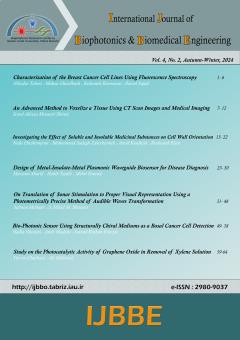Bio-Photonic Sensor Using Structurally Chiral Mediums as a Basal Cancer Cell Detection
Subject Areas : Nano BiophotonicsNadia Ghorani 1 , Amir Madani 2 , Samad Roshan Entezar 3
1 -
2 -
3 -
Keywords: Structurally chiral medium, Surface plasmon polariton, p polarized, Transfer matrix method, Plasmonic mode.,
Abstract :
In this article, a high-accuracy novel optical biosensor consisting of a structurally chiral medium with 4 ̅2m point group symmetry and a silver metallic defect layer under the Sarid configuration is investigated as a theoretical study . We used incident light with p polarization and used the 4 × 4 transfer matrix method for absorption spectrum calculations. Surface plasma polarities (SPP) modes on the interface between a metallic layer and SCM hav
e also been investigated. One of the advantages of using the SCM in this configuration is that it allows us to have several plasmonic and waveguide modes. We have also determined the difference between plasmonic modes and waveguide modes. The resonance angles observed in the absorption spectrum are very sensitive to changes in the fluid placed on top of the sensor and this sensor has a very high-quality factor that distinguishes it from other sensors. The effect of the tilt angle of the SCM has also been investigated. These combinations make the proposed designed sensor unique for performing label-free bioassays in the detection of cancer cells. The basis of this research is to detect cancer cells, which the designed sensor can detect with high sensitivity factors.
[1]. S. E. Swiontek, D. P. Pulsifer, and A. Lakhtakia, “Optical sensing of analytes in aqueous solutions with a multiple surface-plasmon-polariton-wave platform,” Scientific Reports, vol. 3, no. 1, Mar. 2013, doi: 10.1038/srep01409.
[2]. A. Lakhtakia, M. W. McCall, J. A. Sherwin, Q. H. Wu, and I. J. Hodgkinson, “Sculptured-thin-film spectral holes for optical sensing of fluids,” Optics Communications, vol. 194, no. 1–3, pp. 33–46, Jul. 2001, doi: 10.1016/s0030-4018(01)01225-1.
[3]. P. D. McAtee and A. Lakhtakia, “Theory of artificial-neural-network-based simultaneous optical sensing of two analytes using sculptured thin films,” Journal of Nanophotonics, vol. 15, no. 03, Sep. 2021, doi: 10.1117/1.jnp.15.036012.
[4]. S. Swiontek, D. Pulsifer, and A. Lakhtakia, “Optical sensing of analytes via surface multiplasmonics,” SPIE Newsroom, Jul. 2013, doi: 10.1117/2.1201306.004957.
[5]. R. B. M. Schasfoort, “History and Physics of Surface Plasmon Resonance,” Handbook of Surface Plasmon Resonance, pp. 27–59, May 2017, doi: 10.1039/9781788010283-00027.
[6]. S. Pal, N. Pal, Y. K. Prajapati, and J. P. Saini, “Performance Evaluation of SPR Biosensor using Metamaterial over Conventional SPR and Graphene based SPR Biosensor,” 2018 5th International Conference on Signal Processing and Integrated Networks (SPIN), Feb. 2018, doi: 10.1109/spin.2018.8474060.
[7]. S. Swami, F. Kayenat, and S. Wajid, “SPR biosensing: Cancer diagnosis and biomarkers quantification,” Microchemical Journal, vol. 197, p. 109792, Feb. 2024, doi: 10.1016/j.microc.2023.109792.
[8]. F. Babaei and S. A. Seyyedi, “Excitation of Surface Plasmon-Polariton Wave at Both Interfaces of a Silver Thin Film in Two-Layer Kretschmann Geometry,” Plasmonics, vol. 16, no. 6, pp. 2139–2146, Jun. 2021, doi: 10.1007/s11468-021-01476-9.
[9]. S. H. Hosseininezhad and F. Babaei, “Excitation of Multiple Surface Plasmon-Polaritons by a Metal Layer Inserted in an Equichiral Sculptured Thin Film,” Plasmonics, vol. 13, no. 6, pp. 1867–1879, Feb. 2018, doi: 10.1007/s11468-018-0701-y.
[10]. M. R. Hasan et al., “Recent development in electrochemical biosensors for cancer biomarkers detection,” Biosensors and Bioelectronics: X, vol. 8, p. 100075, Sep. 2021, doi: 10.1016/j.biosx.2021.100075.
[11]. L. Fania et al., “Basal Cell Carcinoma: From Pathophysiology to Novel Therapeutic Approaches,” Biomedicines, vol. 8, no. 11, p. 449, Oct. 2020, doi: 10.3390/biomedicines8110449.
[12]. N. Ghorani, A. Madani, and S. R. Entezar, “Real-time biosensor application of structurally chiral medium for detection and sensing of plasma in human blood,” Physica Scripta, vol. 98, no. 5, p. 055518, Apr. 2023, doi: 10.1088/1402-4896/accc5c.
[13]. F. Bayat, S. Ahmadi-Kandjani, and H. Tajalli, “Designing Real-Time Biosensors and Chemical Sensors Based on Defective 1-D Photonic Crystals,” IEEE Photonics Technology Letters, vol. 28, no. 17, pp. 1843–1846, Sep. 2016, doi: 10.1109/lpt.2016.2573852.
[14]. H. Pashaei Adl, F. Bayat, N. Ghorani, S. Ahmadi-Kandjani, and H. Tajalli, “A Defective 1-D Photonic Crystal-Based Chemical Sensor in Total Internal Reflection Geometry,” IEEE Sensors Journal, vol. 17, no. 13, pp. 4046–4051, Jul. 2017, doi: 10.1109/jsen.2017.2701845.
[15]. M. Franco-Ortiz, A. Corella-Madueño, R. A. Rosas-Burgos, J. A. Reyes, and C. G. Avendaño, “Electrically tuned optical reflection band for an artificial helicoidal structure,” Journal of Modern Optics, vol. 65, no. 17, pp. 1994–2005, Jun. 2018, doi: 10.1080/09500340.2018.1482015.
[16]. C. G. Avendaño and D. Martínez, “Tunable omni-directional mirror based on one-dimensional photonic structure using twisted nematic liquid crystal: the anchoring effects,” Applied Optics, vol. 53, no. 21, p. 4683, Jul. 2014, doi: 10.1364/ao.53.004683.
[17]. J. A. Reyes and A. Lakhtakia, “Electrically controlled optical bandgap in a structurally chiral material,” Optics Communications, vol. 259, no. 1, pp. 164–173, Mar. 2006, doi: 10.1016/j.optcom.2005.08.034.
[18]. C. G. Avendaño, I. Molina, and J. A. Reyes, “Anchoring effects on the electrically controlled optical band gap in twisted photonic liquid crystals,” Liquid Crystals, vol. 40, no. 2, pp. 172–184, Oct. 2012, doi: 10.1080/02678292.2012.735706.
[19]. I. Abdulhalim, “Analytic propagation matrix method for anisotropic magneto-optic layered media,” Journal of Optics A: Pure and Applied Optics, vol. 2, no. 6, pp. 557–564, Oct. 2000, doi: 10.1088/1464-4258/2/6/310.
[20]. M. Faryad and A. Lakhtakia, “The circular Bragg phenomenon,” Advances in Optics and Photonics, vol. 6, no. 2, p. 225, Jun. 2014, doi: 10.1364/aop.6.000225.


